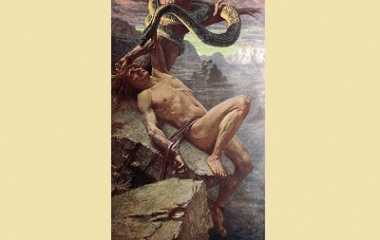- Origin: Norse
- Role: God
- Symbol: Snake
- Parents: Farbauti and Laufey
- Wife: Sigu
- Other Names: Loke, Loder, Lokkju, Lopter
Who Is Loki?
In Norse mythology, Loki was known as the sneaky and trickster god. He caused endless trouble for both mortals and gods but there were times when he used his trickery for good. He lived in Asgard and was often found with Thor or Odin. He enjoyed mischief and can be found in many myths living up to his reputation.
Purpose
Loki didn’t have a traditional role as many other gods. Instead, he served as more of a sidekick, using his mischievous nature to both deter and assist other gods.
Origins
Something that makes Loki different from other gods is that historians have been able to explain the meaning of his name. When it comes to Norse mythology, many of the gods have an obvious source of origin. The accepted suggestion comes from the Viking Age. The noun “loki” means “knot” or “tangle” which could symbolize Loki’s ability to snag other’s plans. It could also be linked to Loki’s ability to make nets.
Legends and Stories
Loki can be found throughout many Norse myths, either helping the gods in their quests or causing them headaches along the way. The following myth focuses on a punishment Loki received for his mischief.
The Myth of Loki
The Norse gods spent most of their time in heaven, enjoying the splendor that surrounded them. They did on occasion look down and check in on the men and giants that roamed the earth. Once, Loki opened up a crack to heaven, which allowed the giants to reach up and take the apples of eternal life that grew in heaven’s orchard. With the crack open, Time was able to enter heaven and leave all the gods with wrinkles and gray hair. But Loki apologized and the gods believed he would never do something so reckless again.
There was a god named Baldr and he was the most beautiful of the gods. He was known for his purity and embodied all things good. Everyone loved Baldr and no one could imagine any harm coming to him. But Baldr began to have dreams that he would suffer a terrible and violent death.
Baldr’s mother, Frigg, was upset by the premonitions her son was having so she set out to demand a promise from all living things. She asked every creature and plant to never hurt her son. The move was impressive and admired by the other gods. With all living things in unison, Frigg knew no one would harm her son.
The gods turned this into a game. They would throw rocks and weapons at Baldr, yet all the items would either disintegrate or drop before Baldr’s feet. He was never harmed. While the other gods were amused by this, Loki found it all very irritating. He made sure that no one knew how he felt but he couldn’t stand so much perfection.
So Loki, being a shapeshifter, changed himself into an old woman so that he could talk with Frigg without her knowing she was talking to Loki. He commented on how amazing Baldr was and how he seemed to be invincible. It was then that Frigg admitted she skipped one plant when asking for her son’s protection. The plant was mistletoe and because it was so small and appeared to be harmless, Frigg had skipped it.
This was all Loki needed to know. He headed to earth and grabbed some mistletoe. He came across Hod, a blind god, and asked him why he had never thrown anything at Baldr like the other gods did for fun. Hod replied that because he was blind and had no weapon, he never saw much of a reason to join in. Loki handed over the mistletoe and told Hod that he would guide his hand. Hod, thinking nothing of the so-called weapon, agreed.
The mistletoe struck Baldr in the neck and instantly killed him. Loki immediately began to laugh, giving away his guilt, so he began to run. But the gods knew what had happened and caught him. They came up with a fitting punishment. They removed the intestines of one of Loki’s sons and used it to tie up the god on a rock in a chamber. There was a cobra that would drip burning venom on Loki’s face for the rest of all eternity.
Loki’s wife, Sigu, demanded that she be allowed to stay with her husband. The gods relentingly agreed. Sigu would stand with a bowl to catch the venom but she would sometimes have to leave to dump it out. During this time, Loki would contort in pain as the venom dripped on his face. This is the Norse explanation for earthquakes.
Family
Loki’s father was a giant named Farbauti and his mother was Laufey, who was believed to be a goddess or a giantess. Loki and the giantess Angrboda had a relationship. Their children were Hel, the goddess of the underworld, Jormungand, the giant serpent who would slay Thor, and Fenir, a wolf.
Loki was married to Sigu, and together they had a son named Nari. As a shapeshifter, Loki also became the mother of Sleipnir, Odin’s horse.
Appearance
Loki was jester-like in appearance, with many artistic representations showing him dancing and sneering. His nose is often depicted as large. You’ll find several variations of Loki, as he was a shapeshifter and could alter his appearance as desired.
Symbology
The main symbol associated with Loki is a snake, as it represents his cunning and mischievous behavior.











Very cool, but what about the other stories about Loki? Missing the stuff with the goat and him turning into a bird and pooping on everything. Heard how he killed Baldr several times already. Not new concept. Desperate for more info!!!! (I love how you are straight and to the point by the way)
AWESOME
what cool stuff
ikr so epic sauce!!!